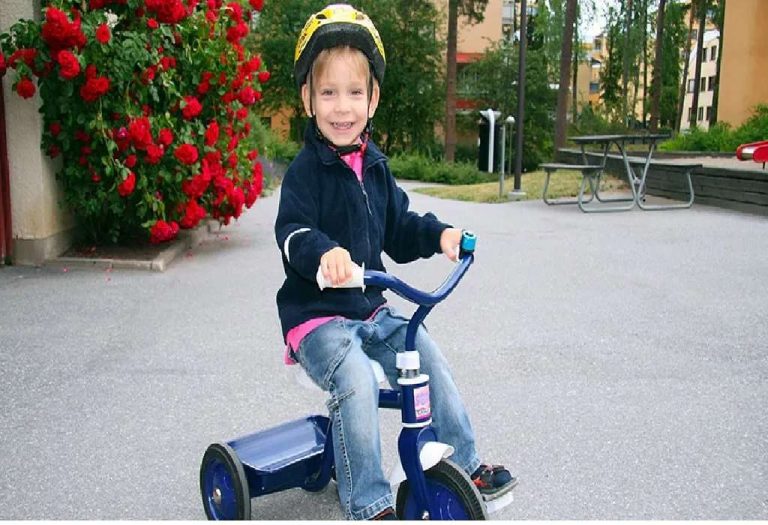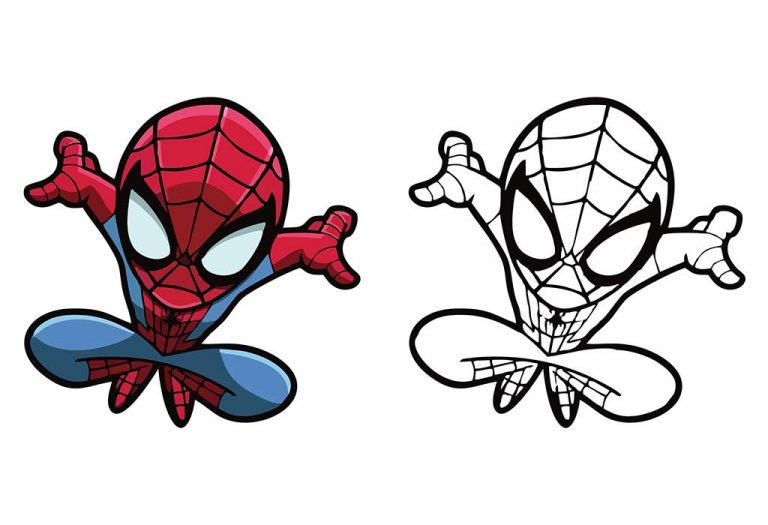8 Best Ways to Teach Child to Ride a Tricycle
- What Age Can a Child Ride a Tricycle?
- How to Teach Your Child to Ride a Tricycle?
- Activities That Help a Child to Ride a Tricycle
- Things Parents Should Keep in Mind While Teaching Their Child to Ride a Tricycle
- FAQs
Is your toddler fond of tricycles? Do you want to gift one to your kid and teach him how to ride a tricycle properly? Well, that’s a great idea and you are in the right place! A tricycle is a fun vehicle that your preschooler can control and enjoy riding when he is just about 2 or 3 years old. Riding a tricycle can help develop your child’s motor skills and coordination. So, you need to boost your toddler’s morale and teach him some of the best, most effective ways to ride a tricycle successfully. And if you are looking for tips and tricks to teach your child how to ride a tricycle, think no further. Read on to know 7 ways to help your child ride a tricycle with confidence.
What Age Can a Child Ride a Tricycle?
Children typically start riding tricycles around the age of 2 or 3, although this can vary depending on the child’s physical development and coordination. At this age, many children have developed enough balance and coordination to begin riding a tricycle independently. However, some children may start earlier or later, so it’s essential to consider individual readiness rather than strictly adhering to a specific age range.
How to Teach Your Child to Ride a Tricycle?
Teaching your child to ride a tricycle can be a fun and rewarding experience. Here are a few tips to help your child master tricycle riding:
1. Start with a Trike
One of the best ways to teach your child to ride a tricycle is by helping your toddler learn to ride a trike, a smaller version of a tricycle. Once your toddler masters handling the trike, he can move on to a bigger tricycle. Choose a push trike without pedals so that your preschooler learns and masters the important skill of pushing the trike by using his feet. If you choose a trike with pedals, your kid may enjoy sitting on the big trike but avoid pushing it which prevents him from mastering an important skill.
2. Choose a Right Sized Tricycle
Once your toddler masters managing a push trike, you can introduce the right sized tricycle to him. Choose a tricycle which is small enough to help your toddler sit easily and comfortably and is at an appropriate height too. Ensure your preschooler’s feet are well-placed on the pedals, with his knees bent slightly. Also, make sure your toddler’s hand can reach the handlebars easily.
3. Teach Pedaling
Pedaling is a crucial motor skill that your toddler needs to master for a range of reasons. Learning and mastering pedaling helps improve bi-lateral co-ordination, boosts your kid’s confidence in performing physical activities, increases muscular strength, and enhances postural stability. Balancing a tricycle is not a problem for your toddler due to the presence of three balancing wheels. First, make your toddler understand that his tricycle can move only by pushing the pedals. To make him understand this, slowly push the tricycle forward. This gives your toddler the right view and feel of the rotating pedals that makes his tricycle move forward.
4. Make Kid Sit in The Right Position
Make sure your toddler places his hands on the tricycle’s handlebars and his feet on the tricycle’s pedals. Tell your preschooler not to lean on the handlebars. Guide your toddler to sit straight when riding the tricycle. Sitting in the right position is one of the keys to manage this toy vehicle efficiently.
5. Push The Tricycle Appropriately
Once your toddler sits in the right position on the tricycle, you can start pushing it slowly. Hold the tricycle with one hand on the handlebars and the other hand at the back of your kid’s seat and push the tricycle slowly. Make sure you stop pushing the tricycle every time your toddler takes his feet off the pedals. Continue to push only when he repositions himself. This will make your preschooler understand the pedaling skill and knack of riding the tricycle, and you will find him riding it all by himself in no time.
6. Ride In a Sprawling, Smooth Space
Let your child learn riding the tricycle in an open, obstacle-free, and safe area. Your toddler can learn pedaling quickly at his own pace without any fear of hitting someone or something. Stay away from padded areas like lawns and grassy areas as although they will act as a cushion when your child falls, they will make pedalling tough for your little one.
7. Acquaint With Safety Gear
Lastly, make your toddler wear a helmet every time he gets on his tricycle. Explain to him that a helmet is essential as it prevents the risk of head injuries. Also, make your preschooler wear fitting elbow and knee pads while riding his toy vehicle. Never allow your toddler to ride his tricycle without putting on a helmet and other safety gear. Soon, it will become a habit, and your child will ride the toy vehicle safely.
8. Offer Encouragement
Praise your child’s efforts and progress as they learn to ride the tricycle. Positive reinforcement can boost their confidence and motivation to keep practicing until they become proficient riders.
Activities That Help a Child to Ride a Tricycle
Introducing your child to activities supporting tricycle riding can make learning enjoyable and effective. These activities focus on developing balance, coordination, and confidence, essential tricycle skills:
1. Moving Forward on a Riding Toy
Children often start by pushing backwards on a riding toy. Encourage forward movement by supporting the child’s lower legs with bent knees and guiding their feet to push against the ground. Allow the child to attempt this movement independently, offering motivation if necessary. Initially, the child may move both legs together, gradually progressing to alternating legs for a longer stride. Ensure the child maintains proper trunk and pelvis positioning for efficient leg movement. If the child’s trunk is leaning back, gently encourage a forward-leaning position by applying pressure to the lower back.
2. Mounting and Dismounting a Riding Toy or Tricycle
When practicing mounting and dismounting, ensure the riding toy remains stable by holding it securely. Positioning is crucial for success. Guide the child to stand beside the seat, facing the handlebars. Encourage lifting the closest leg over the seat with both hands on the handlebars. Provide assistance to help the child plan and execute the leg movement. Once both legs are on either side of the seat, prompt the child to sit down. To dismount, the child can stand up, hold onto the handlebars, lift one leg over the seat, and dismount.
3. Tricycle Riding with Support for Pedaling and Steering
Once the child demonstrates genuine interest in the tricycle and their legs can comfortably reach the pedals, introduce riding with support. Ensure proper setup and fit of the tricycle to facilitate learning.
4. Steering on a Riding Toy
After mastering forward movement, introduce steering on the riding toy. Initially, allow the child to encounter obstacles and then assist as needed. Use verbal cues like “turn” while guiding the child’s hands to manipulate the handlebars. Gradually, encourage independent steering by providing guidance before the child encounters obstacles. Offer opportunities for the child to develop independent steering skills and effective obstacle avoidance through motor planning.
Things Parents Should Keep in Mind While Teaching Their Child to Ride a Tricycle
Teaching your child to ride a tricycle can be an exciting milestone. However, you must consider several factors to ensure a safe and successful learning experience. Here are some key things you should keep in mind while teaching your child to ride a tricycle:
- Patience is Key: Every child learns at their own pace, so be patient and supportive throughout the learning process. Avoid putting pressure on your child and celebrate their progress, no matter how small.
- Safety First: Prioritize safety by ensuring your child wears a properly fitted helmet every time they ride their tricycle. Teach them basic safety rules, such as looking both ways before crossing the street and staying within designated riding areas.
- Encouragement and Positive Reinforcement: Offer plenty of encouragement and praise to boost your child’s confidence. Focus on their efforts rather than just the end result, and let them know that it’s okay to make mistakes as long as they keep trying.
FAQs
1. Is there an optimal time of day to practice riding?
While there’s no universal answer, some children may be more receptive to learning at specific times of the day. Experiment with different times and observe when your child seems most alert and engaged. For some, mornings might be ideal, while others prefer the afternoon or early evening.
2. Should I let my child decorate their tricycle?
Allowing your child to personalise their tricycle with stickers, streamers, or paint can enhance their sense of ownership and motivation to ride. However, ensure decorations don’t obstruct visibility or safety features. Use child-safe materials and involve them in decoration to foster creativity and pride in their tricycle.
In a nutshell, teaching your kid to ride a tricycle is a journey full of fun and learning. Stick to these tips, be patient, and put safety first. Celebrate the little wins along the way, and enjoy the special moments of growth and discovery together. Before you know it, your little one will be zooming around with a big smile, feeling like they own the sidewalk!
Also Read:
Essential Safety Tips For Toddler Cycling
Amazing Health Benefits of Cycling for Kids
Easy Tips to Teach a Child to Ride a Bicycle
The Right Time to Buy Your Child his First Tricycle
Was This Article Helpful?
Parenting is a huge responsibility, for you as a caregiver, but also for us as a parenting content platform. We understand that and take our responsibility of creating credible content seriously. FirstCry Parenting articles are written and published only after extensive research using factually sound references to deliver quality content that is accurate, validated by experts, and completely reliable. To understand how we go about creating content that is credible, read our editorial policy here.























